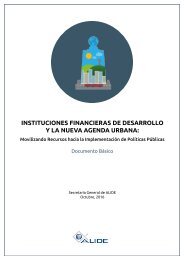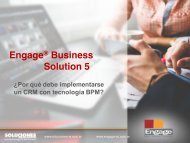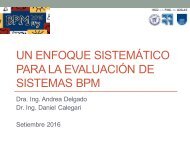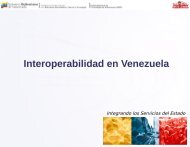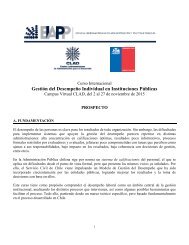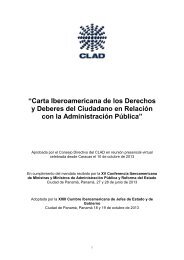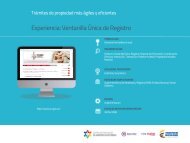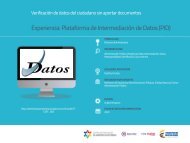INNO_3590_FTFXIV_El_arte_de_innovar_y_emprenderv2_
INNO_3590_FTFXIV_El_arte_de_innovar_y_emprenderv2_
INNO_3590_FTFXIV_El_arte_de_innovar_y_emprenderv2_
Create successful ePaper yourself
Turn your PDF publications into a flip-book with our unique Google optimized e-Paper software.
3<br />
Las piezas que configuran el puzle <strong>de</strong> la innovación nacional<br />
Financiación<br />
Ciclo <strong>de</strong> vida <strong>de</strong> un proyecto empresarial<br />
Formación <strong>de</strong> la empresa<br />
Subvenciones<br />
<strong>de</strong><br />
investigación<br />
Subvenciones<br />
<strong>de</strong><br />
<strong>de</strong>sarrollo<br />
(por ejemplo<br />
SBIR)<br />
Amigos,<br />
familiares y<br />
fundadores($5-$50k)<br />
Inversores<br />
ángeles<br />
($50-<br />
$500k)<br />
Capital riesgo<br />
<strong>de</strong> etapa<br />
inicial<br />
($500k-<br />
$2M+)<br />
Capital<br />
riesgo<br />
($2M-$50M)<br />
Capital<br />
privado,<br />
financiación<br />
<strong>de</strong> proyecto<br />
($2M-$50M)<br />
Salida<br />
a bolsa,<br />
fusión o<br />
adquisición<br />
($25M+)<br />
Flujo neto <strong>de</strong><br />
efectivo<br />
“Valle <strong>de</strong> la muerte”<br />
Investigación<br />
básica<br />
Etapa <strong>de</strong><br />
<strong>de</strong>sarrollo <strong>de</strong>l<br />
proceso<br />
empresarial<br />
Investigación<br />
aplicada<br />
Prueba <strong>de</strong>l<br />
concepto<br />
Mercado<br />
objetivo<br />
Plan <strong>de</strong><br />
negocio<br />
Prototipos<br />
<strong>de</strong> trabajo<br />
Equipo<br />
fundador<br />
Prototipos <strong>de</strong><br />
diseño<br />
Contratos <strong>de</strong><br />
proveedores<br />
Prototipos <strong>de</strong><br />
producción<br />
Contratos <strong>de</strong><br />
distribución<br />
Introducción<br />
<strong>de</strong> producto<br />
Crecimiento<br />
<strong>de</strong> ingresos<br />
Ilustración 15: <strong>El</strong> ciclo <strong>de</strong> vida inicial <strong>de</strong> una empresa.<br />
Fuente: UCDavis, Center for Entrepreneurship.<br />
http://andrewhargadon.typepad.com/my_weblog/2010/04/into-the-valley-of-<strong>de</strong>ath.html.<br />
negocio factible. Esta financiación inicial suele proce<strong>de</strong>r <strong>de</strong> las tres conocidas F:<br />
friends, family and foun<strong>de</strong>rs (amigos, familia y fundadores) –también conocidas<br />
en tono irónico como friends, family and fools (amigos, familia e idiotas)–. Steve<br />
Jobs y su socio, Steve Woznicik, vendieron su Volkswagen y una calculadora<br />
programable con el fin <strong>de</strong> reunir 1.350 dólares para construir el primer PC <strong>de</strong><br />
Apple en un garaje en 1976 67 . Y los cofundadores <strong>de</strong> Hewlett-Packard, Bill Hewlett<br />
y Dave Packard empezaron a trabajar juntos en un garaje con una inversión inicial<br />
<strong>de</strong> 538 dólares 68 . En esta primera etapa los empren<strong>de</strong>dores hacen uso <strong>de</strong> sus<br />
fondos y sus relaciones personales para obtener dicha financiación, ya se trate <strong>de</strong><br />
inversiones pequeñas como en los ejemplos mencionados, o <strong>de</strong> los 20 millones <strong>de</strong><br />
libras que la familia Ryan invirtió en los orígenes <strong>de</strong> la compañía aérea Ryanair 69 .<br />
67<br />
Andrew J. Sherman, Raising<br />
capital: get the money you need to<br />
grow your business.<br />
68<br />
Andrew J. Sherman, Raising<br />
capital: get the money you need to<br />
grow your business.<br />
69<br />
http://www.ryanair.com/ie/about.<br />
70<br />
http://www.cictr.com/.<br />
Las relaciones personales y profesionales son un factor que pue<strong>de</strong> <strong>de</strong>terminar la<br />
puesta en marcha <strong>de</strong> un negocio. Por este motivo, universida<strong>de</strong>s y escuelas <strong>de</strong><br />
negocio ponen mucho énfasis en sus re<strong>de</strong>s <strong>de</strong> alumnos. Los vínculos construidos<br />
en las etapas <strong>de</strong> formación superior han sido origen <strong>de</strong> importantes innovaciones.<br />
Tanto los fundadores <strong>de</strong> Hewlett-Packard como los <strong>de</strong> Google (Larry Page y Sergey<br />
Brin), se conocieron en sus etapas universitarias en Stanford. Pero existen otros<br />
métodos <strong>de</strong> fomentar los vínculos entre empren<strong>de</strong>dores. Entre ellos se encuentran<br />
las incubadoras, como el Centro <strong>de</strong> Innovación <strong>de</strong> Cambridge, Massachusetts 70 ,<br />
que ofrecen instalaciones y servicios <strong>de</strong> primera clase a start-ups y empresas<br />
en crecimiento, al mismo tiempo que proporciona vínculos profesionales. Al<br />
concentrar a los empren<strong>de</strong>dores bajo un mismo techo, las incubadoras no sólo se<br />
convierten en punto <strong>de</strong> encuentro para el talento, sino también para inversores<br />
«ángel» y capital riesgo, que pue<strong>de</strong>n ofrecer financiación en etapas posteriores <strong>de</strong>l<br />
ciclo <strong>de</strong> vida <strong>de</strong> la empresa.<br />
Los inversores ángel y el capital riesgo constituyen el combustible <strong>de</strong> la<br />
innovación. Sirven <strong>de</strong> puente en el “valle <strong>de</strong> la muerte”, ya que proporcionan<br />
los fondos que permiten a las empresas superar el período inicial <strong>de</strong> pérdidas.<br />
Buscan rentabilida<strong>de</strong>s más altas que los acreedores tradicionales –bancos y<br />
© 2010 Fundación <strong>de</strong> la Innovación Bankinter. All rights reserved.<br />
57




